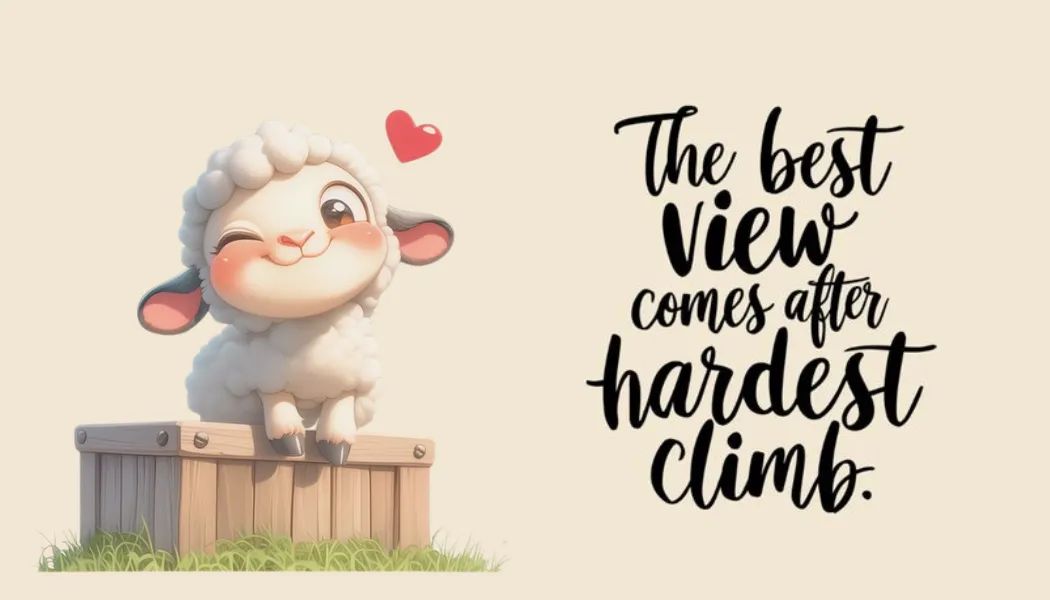Life is often compared to a journey, filled with smooth paths, unexpected turns, and steep mountains that test our strength. The quote, “The best view comes after the hardest climb,” beautifully captures the truth that the most rewarding moments in life often come after struggles, challenges, and relentless perseverance.
This isn’t just about literal mountains. It’s a metaphor for every challenge we face—whether it’s chasing dreams, building a career, recovering from failure, or overcoming personal struggles. The climb represents the effort, sweat, and resilience it takes to move forward. The view at the top represents the success, peace, and fulfillment that make the struggle worthwhile.
In this article, we’ll dive deep into the meaning of this quote, why hardships are essential for growth, how to face life’s climbs with courage, and how to enjoy the “view” once you reach your destination.
Table of contents
- Understanding the Quote
- Why Challenges Are Necessary
- Real-Life Examples of Hard Climbs
- The Emotional Side of the Climb
- How to Keep Climbing When It Gets Hard
- The Joy of the View
- Lessons From the Climb
- A Daily Mindset Shift
- Overcoming the Fear of Hard Climbs
- The Ripple Effect of Reaching the Top
- Conclusion: Keep Climbing
Understanding the Quote
At first glance, the quote may seem simple—it’s about pushing through difficulties to enjoy the rewards. But beneath the simplicity lies a profound truth: without the climb, there is no view. If the road was always easy, the reward wouldn’t feel as valuable.
The “climb” represents the struggles in your personal, professional, or emotional life. It could be late nights studying, years spent working toward a career, or personal battles against fear, failure, or self-doubt. The “view” represents the reward—success, peace of mind, growth, or the achievement of something you once thought impossible.
The connection between the two is what makes this quote so powerful: the harder the climb, the more beautiful the view.
Why Challenges Are Necessary
Life without challenges would be dull. Imagine a world where everything you wanted came instantly. Would achievements hold the same value? Likely not. It’s the difficulty that makes rewards meaningful.
- Challenges Build Strength
Just like muscles grow when they’re challenged with resistance, our character grows stronger when we face obstacles. - Challenges Teach Lessons
Failure, though painful, often teaches us more than success. Each setback carries a lesson that shapes us for future climbs. - Challenges Give Perspective
Once you’ve faced hardship, you appreciate success more deeply. The sweetness of victory comes from remembering the bitterness of struggle. - Challenges Create Resilience
Resilience is the ability to bounce back. It’s forged in tough times when giving up feels easier than going on.
Real-Life Examples of Hard Climbs
J.K. Rowling’s Journey
Before becoming one of the most famous authors in the world, Rowling was a struggling single mother on welfare. Her manuscript for Harry Potter was rejected multiple times before it was accepted. Her climb was filled with hardship, but her “view” turned into a literary empire that inspires millions.


Nelson Mandela’s Struggle
Mandela spent 27 years in prison fighting against apartheid in South Africa. It was one of the hardest climbs imaginable. Yet, his release and leadership brought peace, freedom, and equality to his nation. His view was not just personal success, but collective triumph.
Everyday Heroes
Even ordinary people face extraordinary climbs. Parents who work tirelessly to provide for their families, students battling against the odds to get an education, or individuals overcoming illness—all show us that the most beautiful victories come after difficult struggles.
The Emotional Side of the Climb
The climb is not just physical—it’s mental and emotional too. Along the way, you’ll face:
- Self-doubt: The voice that whispers you’re not strong enough.
- Fear: The worry of failing or never reaching the top.
- Loneliness: The climb can sometimes feel like a solitary journey.
- Temptation to quit: When the path feels endless, giving up seems easier.
But these emotions are natural. They’re part of the climb. The key is to push through them, step by step, reminding yourself that the view is worth it.
How to Keep Climbing When It Gets Hard
- Break It Into Small Steps
Big goals can feel overwhelming. Focus on the next step, not the entire mountain. - Find Your “Why”
Remind yourself why you started the climb in the first place. A strong “why” fuels perseverance. - Embrace Failure as Feedback
Instead of seeing failure as the end, treat it as a guidepost. Learn, adjust, and keep moving. - Surround Yourself With Support
A climb is easier with encouragement. Surround yourself with people who lift you up. - Celebrate Progress
Every step forward is an achievement. Acknowledge it, even if you’re not at the top yet.
The Joy of the View
When you finally reach the top of your climb, the reward is sweeter because of the struggle. The “view” could be achieving a dream job, finding peace after emotional turmoil, reaching financial independence, or simply growing into a stronger version of yourself.
The view represents not just the achievement but also the journey itself. Looking back at how far you’ve come fills you with gratitude, pride, and perspective.
Lessons From the Climb
- Patience Pays Off: Success rarely happens overnight.
- Growth Is in the Struggle: You become stronger during the climb, not at the top.
- Gratitude Deepens Joy: The harder the path, the more grateful you’ll be for the outcome.
- Persistence Wins: Those who keep going despite obstacles eventually reach their goals.
A Daily Mindset Shift
You don’t have to be climbing a literal mountain to apply this wisdom. Every challenge in daily life—whether it’s learning a skill, improving your health, or maintaining relationships—can be seen as a climb. Instead of dreading it, remind yourself:
- The effort is temporary.
- The reward is lasting.
- The view will be worth it.
Overcoming the Fear of Hard Climbs
Sometimes, the hardest part is starting. Fear of failure or the unknown can hold us back. Here’s how to overcome it:
- Visualize the View: Picture the reward waiting for you at the top.
- Focus on Effort, Not Perfection: Progress matters more than flawless execution.
- Accept Discomfort: Growth always feels uncomfortable at first.
- Take the First Step: Action breaks fear faster than overthinking.
The Ripple Effect of Reaching the Top
Your success isn’t just for you. When you complete your climb, you inspire others. Your story becomes proof that persistence works. Someone else facing their mountain might find courage because of your journey.
Conclusion: Keep Climbing
Life’s most beautiful moments often come after its toughest challenges. The climbs may be exhausting, the path uncertain, and the obstacles discouraging, but the view at the top makes it all worthwhile.
So, the next time you face a tough challenge, remember this quote: “The best view comes after the hardest climb.” Don’t give up halfway. Keep going. The summit holds a reward beyond imagination.
And when you finally reach it, you’ll realize the climb wasn’t just about the view—it was about who you became along the way.
